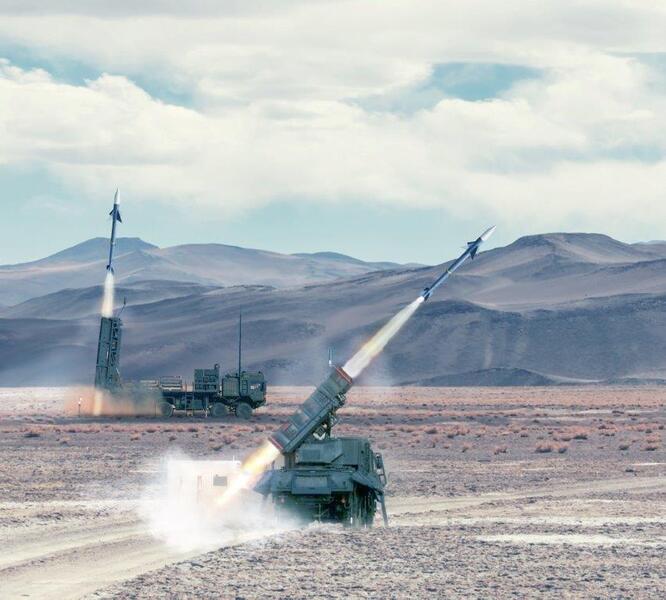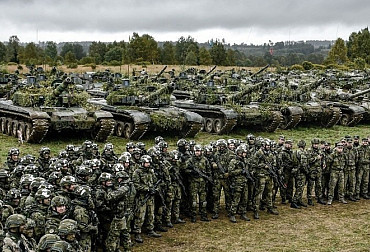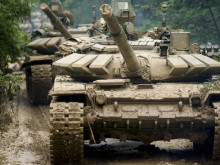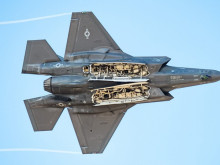Ballistic missiles are a challenge for the future Czech air defence system
The recent attack on the Ukrainian capital Kiev has once again shown that the need to design air defence not only against cruise missiles but also against ballistic missiles is more than topical. The war in Ukraine has renewed the focus on the Czech Republic's modern air defence, which is to be strengthened by the delivery of the SPYDER short-range air defence system from the Israeli company Rafael.
 Picture: The war in Ukraine has renewed the focus on the Czech Republic's modern air defence, which is to be strengthened by the delivery of the SPYDER short-range air defence system from the Israeli company Rafael. | Ministry of Defence of the Czech Republic
Picture: The war in Ukraine has renewed the focus on the Czech Republic's modern air defence, which is to be strengthened by the delivery of the SPYDER short-range air defence system from the Israeli company Rafael. | Ministry of Defence of the Czech Republic
The Czech Army is expected to receive a total of four batteries of the SPYDER anti-aircraft missile system by 2026, each of which will include a radar, four launchers, a reloading vehicle and command and fire control systems.
Rafael, the supplier of the new SPYDER system, recently boasted that its air defence system can also counter ballistic missiles thanks to the upgrade. "The new capability relies on the Derby LR anti-missile missile, which has undergone hardware and software upgrades, and has been adapted to customer requirements and based on experience gained from operational deployment," a company official said.
The company further said the additional capability "included research and analysis of lessons learned from recent and ongoing armed conflicts involving the extensive use of tactical ballistic missiles."
SPYDER for the Czech Republic
The SPYDER system uses the Elta EL/M-2084 radar, which is a major advantage for the Czech Army, as the same type is now being introduced into its arsenal as a 3D surveillance radar of the MADR category. All elements of the system will be installed on Tatra 815-7 chassis (8×8 and 6×6).
Each battery of the SPYDER system will provide protection of an area of 55 x 55 km, which in the case of four batteries is mathematically less than 16% of the area of the Czech Republic. The main task is to secure objects of national defence importance (ODOS), both military and non-military, as decided by the government.
The document 'Concept for the Build-up of the Army of the Czech Republic 2030' (KVAČR 2030) specifies that there should be no more than three such facilities. We can certainly imagine the absolute necessity of defending both the capital and the two nuclear power plants. If we consider the scale and strength of the Russian Federation's attacks against Ukraine, four batteries will not cover nearly everything we would wish to protect.
If in peacetime, for example against a terrorist threat, a single anti-aircraft missile squad containing several batteries may be sufficient (more for maintaining capabilities within the armed forces), for deployment in a symmetrical high-intensity conflict it is a rather negligible force.
The air defence systems of Poland and Germany
The feeling that the Czech Republic stands far away from the hotbeds of potential conflicts should have left us completely. We can look, for example, to Poland, which is modernising its armed forces at an accelerating pace. In the field of ground-based air defence, it will rely primarily, in addition to various VSHORAD systems (for example, the Narew system developed in cooperation between MBDA and PGZ-Narew) and the old Soviet S-125 and S-200 systems, on eight batteries of the US Patriot Medium Range Air Defence System (64 launchers) and two batteries (six launchers) of the British CAMM system. Further reinforcement of air defence by deploying Patriot batteries was offered to Poland by Germany.
Today, the German Bundeswehr (Luftwaffe) has one anti-aircraft missile squadron (Flugabwehrraketengeschwader 1 "Schleswig-Holstein"), to which all surface-to-air missile units of the German Air Force are subordinated, with the exception of Flugabwehrraketengruppe 61 (integrated into the Dutch air defence).
In addition to the Air Defence Centre, the squadron consists of three groups (Nos 21, 24 and 26) at Sanitz, BadSülze and Husum. The units are deployed to protect areas, objects or groups of objects as well as mobile operations. Their mission is to provide extensive and sustained airspace protection. Since the retirement of the HAWK and Roland weapon systems at the end of 2005, ground-based air defence has mainly been carried out using the Patriot system.
In 2013, Germany had twelve batteries. In response to Russian aggression against Ukraine and the need to secure NATO's eastern flank, Germany recently sent an unspecified number of these systems to Slovakia, and is now also offering them to Poland.
Ballistic missiles have not yet been considered
The 2018 document "Modernisation Projects of the Czech Armed Forces" talks about the demanded SHORAD system in the area of fire capabilities only about shooting down aircraft, helicopters, cruise missiles and drones.
The question then is whether the SPYDER system that will be delivered to the Czech Army is capable of countering the threats currently used in the war in Ukraine, namely the tactical ballistic missiles used by Russia, which cause great damage to cities and energy infrastructure in particular.
We asked the Department of Defense whether the SPYDER system sets ordered will have the capability to provide ballistic missile defense or whether implementation of this capability, as an adjunct to the Alliance's existing PRO, is envisioned in the future? We have received the following answer from Colonel Vlastimila Cyprisová from the Public Communications Department of the General Staff of the Czech Armed Forces:
"SPYDER systems are not intended for destroying ballistic targets. They have a technically different solution for detection of air targets and guidance to targets, which limits the action against ballistic missiles. The Army does not plan to implement a ballistic missile defense capability in the SPYDER system at this time. Technically, this implementation is possible only if a special radar is added for detection, specific software processing of target data, and a different kind of missile with more precise guidance using a non-explosive warhead that destroys the ballistic missile with its own kinetic energy."
On the question of the future capability of the Czech air defence system to counter ballistic missiles, Colonel Cyprisová responds as follows: "Building a ballistic missile defence capability will be included in updated strategic defence documents this year (2023, ed.). Technical, time and product consultations are currently underway on the capabilities and offerings of manufacturers of ballistic missile defence systems."
If the supplier of the new air defence system for the Czech Republic, Rafael, does indeed have the necessary knowledge and skills to implement Ballistic Missile Defence (BMD) into the SPYDER system we have ordered, this is certainly crucial information for the Czech Ministry of Defence to continue building this important system.





















